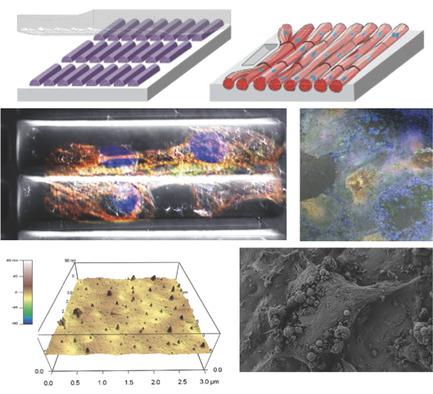当前位置:
X-MOL 学术
›
Adv. Funct. Mater.
›
论文详情
Our official English website, www.x-mol.net, welcomes your
feedback! (Note: you will need to create a separate account there.)
Engineering of Mature Human Induced Pluripotent Stem Cell‐Derived Cardiomyocytes Using Substrates with Multiscale Topography
Advanced Functional Materials ( IF 18.5 ) Pub Date : 2018-03-13 , DOI: 10.1002/adfm.201707378 Parisa P. S. S. Abadi 1, 2 , Jessica C. Garbern 3, 4 , Shahed Behzadi 1 , Michael J. Hill 2 , Jason S. Tresback 5 , Tiam Heydari 6 , Mohammad Reza Ejtehadi 6 , Nafis Ahmed 4 , Elizabeth Copley 1 , Haniyeh Aghaverdi 1 , Richard T. Lee 4, 7 , Omid C. Farokhzad 1 , Morteza Mahmoudi 1
Advanced Functional Materials ( IF 18.5 ) Pub Date : 2018-03-13 , DOI: 10.1002/adfm.201707378 Parisa P. S. S. Abadi 1, 2 , Jessica C. Garbern 3, 4 , Shahed Behzadi 1 , Michael J. Hill 2 , Jason S. Tresback 5 , Tiam Heydari 6 , Mohammad Reza Ejtehadi 6 , Nafis Ahmed 4 , Elizabeth Copley 1 , Haniyeh Aghaverdi 1 , Richard T. Lee 4, 7 , Omid C. Farokhzad 1 , Morteza Mahmoudi 1
Affiliation

|
Producing mature and functional cardiomyocytes (CMs) by in vitro differentiation of induced pluripotent stem cells (iPSCs) using only biochemical cues is challenging. To mimic the biophysical and biomechanical complexity of the native in vivo environment during the differentiation and maturation process, polydimethylsiloxane substrates with 3D topography at the micrometer and sub‐micrometer levels are developed and used as cell‐culture substrates. The results show that while cylindrical patterns on the substrates resembling mature CMs enhance the maturation of iPSC‐derived CMs, sub‐micrometer‐level topographical features derived by imprinting primary human CMs further accelerate both the differentiation and maturation processes. The resulting CMs exhibit a more‐mature phenotype than control groups—as confirmed by quantitative polymerase chain reaction, flow cytometry, and the magnitude of beating signals—and possess the shape and orientation of mature CMs in human myocardium—as revealed by fluorescence microscopy, Ca2+ flow direction, and mitochondrial distribution. The experiments, combined with a virtual cell model, show that the physico‐mechanical cues generated by these 3D‐patterned substrates improve the phenotype of the CMs via the reorganization of the cytoskeletal network and the regulation of chromatin conformation.
中文翻译:

使用多尺度地形学的底物工程化成熟的人类诱导的多能干细胞衍生的心肌细胞
仅使用生化线索通过诱导分化的多能干细胞(iPSC)的体外分化来生产成熟和功能性的心肌细胞(CM)是具有挑战性的。为了模拟分化和成熟过程中天然体内环境的生物物理和生物力学复杂性,开发了在微米和亚微米级别具有3D形貌的聚二甲基硅氧烷底物,并将其用作细胞培养底物。结果表明,虽然类似于成熟CM的基质上的圆柱状图案增强了iPSC衍生CM的成熟度,但通过印迹主要人类CM而获得的亚微米级地形特征进一步加速了分化和成熟过程。2+流动方向和线粒体分布。实验结合虚拟细胞模型表明,这些3D图案底物产生的物理机械线索通过细胞骨架网络的重组和染色质构象的调节改善了CM的表型。
更新日期:2018-03-13
中文翻译:

使用多尺度地形学的底物工程化成熟的人类诱导的多能干细胞衍生的心肌细胞
仅使用生化线索通过诱导分化的多能干细胞(iPSC)的体外分化来生产成熟和功能性的心肌细胞(CM)是具有挑战性的。为了模拟分化和成熟过程中天然体内环境的生物物理和生物力学复杂性,开发了在微米和亚微米级别具有3D形貌的聚二甲基硅氧烷底物,并将其用作细胞培养底物。结果表明,虽然类似于成熟CM的基质上的圆柱状图案增强了iPSC衍生CM的成熟度,但通过印迹主要人类CM而获得的亚微米级地形特征进一步加速了分化和成熟过程。2+流动方向和线粒体分布。实验结合虚拟细胞模型表明,这些3D图案底物产生的物理机械线索通过细胞骨架网络的重组和染色质构象的调节改善了CM的表型。











































 京公网安备 11010802027423号
京公网安备 11010802027423号